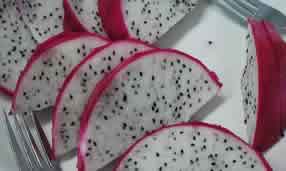Dragon Fruit Scientific Names:
Ceraus, Acanthocereus, Echinocereus, Hylocereus, Selenicereus, Stenocereus, Escontria, Myrthillocactus.
Dragon fruit is also knows as:
Pitaya, Dragon Fruit, Red Pitahaya, Night blooming Cereus, Strawberry Pear, Belle of the Night, conderella plant
Other common names:
French: cierge-lezard, poire de chardon
German: distelbirn, echte stachelbirn, drachenfrucht
Hawaiian: Pa-nani-o-ka
Portoguese: cato-barse, cardo-ananaz
Spanish: pitahaya roja (Colombia, Mexico, Venezuela); flor de caliz, pitajava (Puerto Rico); junco, junco tapatio, pitahaya orejona, reina de la noche, tasajo (Mexico)
Swedish: skogskaktus, röd pitahaya
Dragon fruit or red pitaya belongs to the Cactaceae family from the subfamily Cactoidea of the tribe Cactea . Dragon Fruit also known as Pitaya is a magnificent plant with stunning and beautiful fruit that exhibits vivirant colors and shape. Dragon fruit is not only attractive but is also flavourful that is slightly similar to kiwi and melon.
The Dragon plant is a vine, epiphytic cacti of the genus Hylocereus that is believed to be native in Central and Southern America and has been brought to Southeast Asian countries including Malaysia, Indonesia, Taiwan, Thailand, Sri Lanka, Bangladesh and Vietnam. Dragon plant has fleshy stems that grow up to 20ft long when matured. Dragon plant may grow from the ground or climb onto trees using aerial roots. Dragon plant bears flowers that only bloom at night. The flowers are ornate and beautiful with fragrant scent. Pitahaya plants can have up to 4-6 fruiting cycles per year. The dragon fruit has spines that grows up to 1 kilogram in weight. Dragon fruit skin may be yellowish to dark red in color with edible flesh that maybe white or red depending on the variety. It has a lot of black small seeds that is also edible.
Pitaya or Dragon fruit is also known to have some health benefits that includes preventing memory loss, anti cancer activity, control of blood glucose level in diabeetes, anti-xidant properties, aids in healing of wounds and others.
Dragon fruit Contitutional contents

The typical nutritional values per 100 g of raw pitaya (of which 55 g are edible) are as follows:
- Water 80-90 g
- Ascorbic acid (Vitamin C) 4–25 mg
- Ash 0.4-0.7 g
- Calcium 6–10 mg
- Calories: 35-50
- Carbohydrates 9-14 g
- Carotene (Vitamin A) traces
- Fat 0.1-0.6 g
- Fiber 0.3-0.9 g
- Iron 0.3-0.7 mg Niacin (Vitamin B3) 0.2-0.45 mg
- Phosphorus 16 – 36 mg
- Protein 0.15-0.5 g
- Thiamine (Vitamin B1) traces
- Riboflavin (Vitamin B2) traces
Dragon fruit health Benefits
- Dragon fruit boosts immune system. Dragon fruit is rich in vitamin C and fibers that help provide an overall healthy body.
- Dragon fruit helps in digestion. Because of the richness in fibers, Dragon fruit aids in the digestion of food, Studies also suggest that Dragon fruit promotes the growth of probiotics.
- Dragon fruit help to lower blood glucose levels in type 2 diabetes. Studies also suggest that the the glucose found in Dragon fruit aids in controlling the blood sugar level for diabetes patients.
- Dragon fruit prevent formation of cancer causing free radicals. Dragon fruit is rich in minerals and fibers that aids in digestion, cleans toxic ingredients thus preventing the occurrence of colon cancer.
- Dragon fruit as anti-oxidant. The presence of high level of vitamin C, minerals and pytoalbumin is regarded as relevant in fighting free radicals and possess anti-oxidant properties.
- Dragon fruit helps to control cholesterol level. Dragon fruit is also rich in flavonoids that are known to have favorable effects against cardio related disease.
Folkloric health Benefits from Dragon fruit.
- Dragon fruit promotes healing of wounds and cuts.
- Dragon fruit improves appetite.
- Dragon fruit improves eye sight
- Dragon fruit can aid in weight reduction
- Dragon fruit improves memory.




